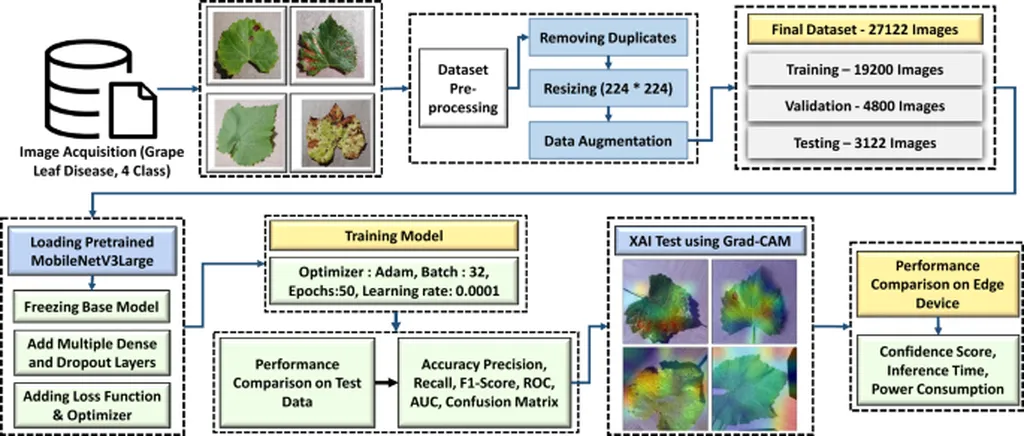In the ever-evolving landscape of precision agriculture, a new lightweight algorithm is making waves, promising to revolutionize the way grape leaf diseases are identified. The algorithm, dubbed MobileNet-GDR (Grape Disease Recognition), is the brainchild of lead author Gang Chen and his team, and it’s causing quite a stir in the agricultural technology community.
MobileNet-GDR is built upon the MobileNetV4-small architecture, a framework known for its efficiency and speed. What sets this algorithm apart is its ability to perform real-time disease diagnosis on mobile devices, a feat that has previously been hindered by the high computational complexity of existing deep learning models.
The algorithm achieves this by constructing an efficient feature extraction module based on depthwise separable convolutions and grouped convolutions. This optimization allows it to significantly reduce computational overhead while maintaining high accuracy. “We’ve managed to strike a balance between performance and efficiency,” Chen explains. “Our model has only 1.75M parameters and 0.18G FLOPs, yet it achieves a classification accuracy of 99.625% and a real-time inference speed of 184.89 FPS.”
The implications of this research are profound for the agriculture sector. Real-time disease diagnosis in the field can lead to timely interventions, preventing the spread of diseases and minimizing crop losses. This is particularly crucial for grape growers, as diseases can quickly devastate vineyards, leading to significant economic losses.
Moreover, the lightweight nature of MobileNet-GDR makes it ideal for deployment on mobile devices, enabling farmers to perform disease diagnosis on-site without the need for specialized equipment. This democratization of technology can empower small-scale farmers, enhancing their productivity and profitability.
The research, published in the journal ‘Frontiers in Plant Science’, also highlights the potential of MobileNet-GDR to outperform mainstream lightweight models like FasterNet and GhostNet in terms of computational efficiency. This could pave the way for its application in other areas of agriculture, such as pest detection and crop monitoring.
As we look to the future, the development of MobileNet-GDR is a testament to the power of deep learning in transforming agriculture. It’s a step towards smarter, more efficient farming practices that can help us meet the growing food demands of a burgeoning global population. The research team’s work is not just about identifying diseases; it’s about cultivating a future where technology and agriculture go hand in hand, driving innovation and sustainability in the field.
In the words of Chen, “This is just the beginning. We’re excited to see how our work can be applied and built upon to further advance the field of precision agriculture.” With such promising potential, MobileNet-GDR is indeed a game-changer, heralding a new era of smart farming.

